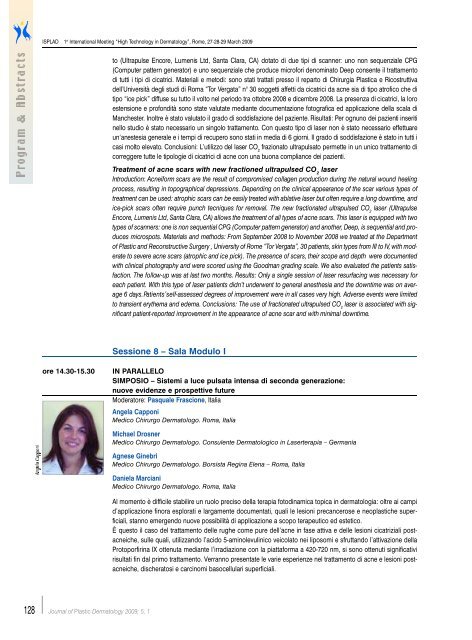Vol. 5, n. 1, January-March 2009 1th International ... - Salute per tutti
Vol. 5, n. 1, January-March 2009 1th International ... - Salute per tutti
Vol. 5, n. 1, January-March 2009 1th International ... - Salute per tutti
You also want an ePaper? Increase the reach of your titles
YUMPU automatically turns print PDFs into web optimized ePapers that Google loves.
128<br />
ISPLAD 1 st <strong>International</strong> Meeting “High Technology in Dermatology”, Rome, 27-28-29 <strong>March</strong> <strong>2009</strong><br />
Journal of Plastic Dermatology <strong>2009</strong>; 5, 1<br />
to (Ultrapulse Encore, Lumenis Ltd, Santa Clara, CA) dotato di due tipi di scanner: uno non sequenziale CPG<br />
(Computer pattern generator) e uno sequenziale che produce microfori denominato Deep consente il trattamento<br />
di <strong>tutti</strong> i tipi di cicatrici. Materiali e metodi: sono stati trattati presso il reparto di Chirurgia Plastica e Ricostruttiva<br />
dell’Università degli studi di Roma “Tor Vergata” n° 30 soggetti affetti da cicatrici da acne sia di tipo atrofico che di<br />
tipo “ice pick” diffuse su tutto il volto nel <strong>per</strong>iodo tra ottobre 2008 e dicembre 2008. La presenza di cicatrici, la loro<br />
estensione e profondità sono state valutate mediante documentazione fotografica ed applicazione della scala di<br />
M a n c h e s t e r. Inoltre è stato valutato il grado di soddisfazione del paziente. Risultati: Per ognuno dei pazienti inseriti<br />
nello studio è stato necessario un singolo trattamento. Con questo tipo di laser non è stato necessario effettuare<br />
un‘anestesia generale e i tempi di recu<strong>per</strong>o sono stati in media di 6 giorni. Il grado di soddisfazione è stato in <strong>tutti</strong> i<br />
casi molto elevato. Conclusioni: L’utilizzo del laser CO 2 frazionato ultrapulsato <strong>per</strong>mette in un unico trattamento di<br />
correggere tutte le tipologie di cicatrici di acne con una buona compliance dei pazienti.<br />
Treatment of acne scars with new fractioned ultrapulsed CO 2 laser<br />
Introduction: Acneiform scars are the result of compromised collagen production during the natural wound healing<br />
process, resulting in topographical depressions. Depending on the clinical appearance of the scar various types of<br />
treatment can be used: atrophic scars can be easily treated with ablative laser but often require a long downtime, and<br />
ice-pick scars often require punch tecniques for removal. The new fractionated ultrapulsed CO 2 laser (Ultrapulse<br />
Encore, Lumenis Ltd, Santa Clara, CA) allows the treatment of all types of acne scars. This laser is equipped with two<br />
types of scanners: one is non sequential CPG (Computer pattern generator) and another, Deep, is sequential and produces<br />
microspots. Materials and methods: From September 2008 to November 2008 we treated at the Department<br />
of Plastic and Reconstructive Surgery , University of Rome “Tor Vergata”, 30 patients, skin types from III to IV, with moderate<br />
to severe acne scars (atrophic and ice pick). The presence of scars, their scope and depth were documented<br />
with clinical photography and were scored using the Goodman grading scale. We also evaluated the patients satisfaction.<br />
The follow-up was at last two months. Results: Only a single session of laser resurfacing was necessary for<br />
each patient. With this type of laser patients didn’t underwent to general anesthesia and the downtime was on average<br />
6 days. Pa t i e n t s ’ s e l f-assessed degrees of improvement were in all cases very high. Adverse events were limited<br />
to transient erythema and edema. Conclusions: The use of fractionated ultrapulsed CO 2 laser is associated with significant<br />
patient-reported improvement in the appearance of acne scar and with minimal downtime.<br />
Sessione 8 – Sala Modulo I<br />
ore 14.30-15.30 IN PARALLELO<br />
SIMPOSIO – Sistemi a luce pulsata intensa di seconda generazione:<br />
nuove evidenze e prospettive future<br />
Moderatore: Pasquale Frascione, Italia<br />
Angela Capponi<br />
Medico Chirurgo Dermatologo. Roma, Italia<br />
Michael Drosner<br />
Medico Chirurgo Dermatologo. Consulente Dermatologico in Laserterapia – Germania<br />
Agnese Ginebri<br />
Medico Chirurgo Dermatologo. Borsista Regina Elena – Roma, Italia<br />
Daniela Marciani<br />
Medico Chirurgo Dermatologo. Roma, Italia<br />
Al momento è difficile stabilire un ruolo preciso della terapia fotodinamica topica in dermatologia: oltre ai campi<br />
d’applicazione finora esplorati e largamente documentati, quali le lesioni precancerose e neoplastiche su<strong>per</strong>ficiali,<br />
stanno emergendo nuove possibilità di applicazione a scopo terapeutico ed estetico.<br />
È questo il caso del trattamento delle rughe come pure dell’acne in fase attiva e delle lesioni cicatriziali postacneiche,<br />
sulle quali, utilizzando l’acido 5-aminolevulinico veicolato nei liposomi e sfruttando l’attivazione della<br />
Protoporfirina IX ottenuta mediante l’irradiazione con la piattaforma a 420-720 nm, si sono ottenuti significativi<br />
risultati fin dal primo trattamento. Verranno presentate le varie es<strong>per</strong>ienze nel trattamento di acne e lesioni postacneiche,<br />
discheratosi e carcinomi basocellulari su<strong>per</strong>ficiali.

















